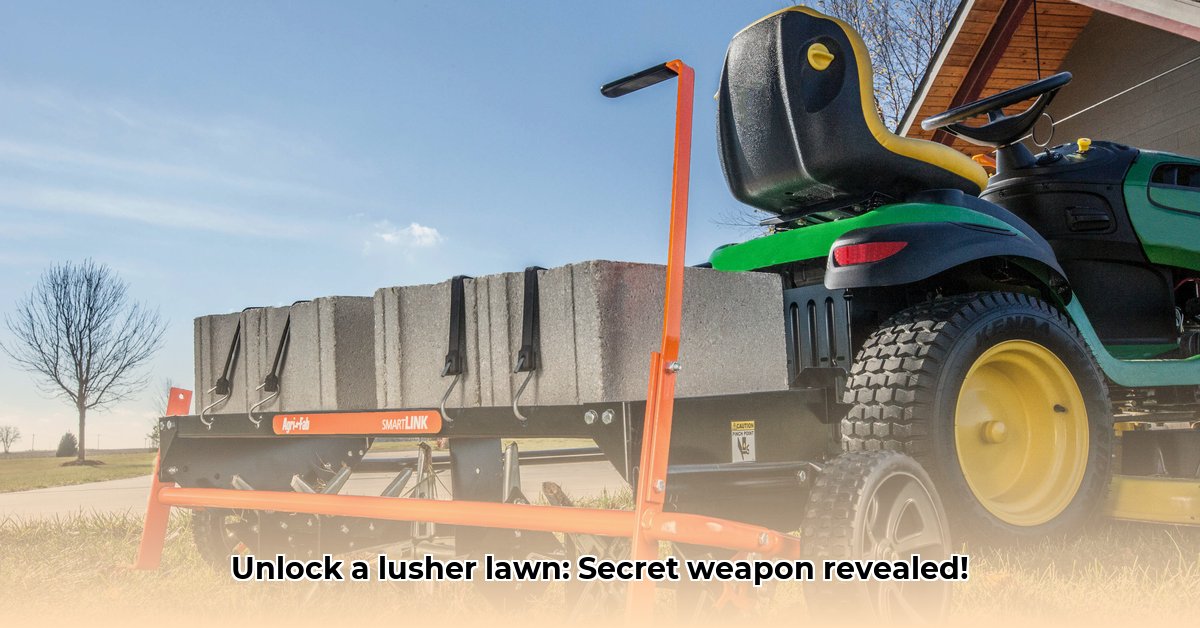
Plug Aerator Tractor Supply: Revitalize Your Lawn with Better Soil
Is your lawn looking lackluster? Does your soil feel hard and compacted? Tractor Supply's plug aerators offer a simple yet effective solution for revitalizing your lawn. Compacted soil acts like a squeezed-out sponge, preventing water and nutrients from reaching your grass's roots. Plug aerators create holes, allowing air and water to penetrate, leading to a healthier, happier lawn. This guide provides a step-by-step process for successful lawn aeration. For more information on Tractor Supply aerators, check out this helpful guide.
Understanding Soil: The Foundation of a Great Lawn
Soil compaction is a common problem, often caused by foot traffic, heavy machinery, or even rainfall. This compaction restricts root growth, leading to yellowing grass, poor drainage, and increased susceptibility to diseases and pests. Essentially, your grass is struggling to get the essentials it needs to thrive. Have you noticed these problematic signs on your lawn?
Picking the Right Plug Aerator at Tractor Supply
Tractor Supply offers various plug aerators. The best choice depends on your lawn's size and your preferred level of effort.
| Feature | Manual Aerator | Tow-Behind Aerator |
|---|---|---|
| Lawn Size | Small to medium-sized lawns | Medium to large lawns |
| Effort Level | More physical exertion required | Less physical effort; more convenient |
| Initial Cost | Lower upfront investment | Higher upfront investment |
| Best For | Smaller lawns, occasional aeration needs | Larger lawns, regular aeration maintenance |
Consider reading online reviews to compare models before making a purchase. Customer feedback can provide valuable insights.
Aerating Your Lawn: A Simple, Step-by-Step Process
Follow these steps for optimal results:
Timing: Aerate in spring or fall when the soil is moist but not saturated. Avoid aerating on extremely hot days or during droughts.
Preparation: Trim your grass short and clear the area of debris to prevent damage to the aerator.
Aeration: Overlap your passes to ensure even coverage. Follow manufacturer instructions carefully.
Post-Aeration Care: Water gently after aerating to settle the soil and promote root growth. Avoid heavy foot traffic for a few days.
The Perks of Plug Aeration: A Healthier Lawn
Plug aeration offers numerous benefits:
- Improved Water Absorption: Say goodbye to dry patches! Aerated soil absorbs water more efficiently.
- Enhanced Nutrient Uptake: Nutrients from fertilizers reach the roots more effectively, promoting lusher growth.
- Reduced Thatch: Aeration helps reduce thatch buildup, preventing suffocation of the lawn.
- Less Fertilizer Needed: Improved nutrient uptake may reduce the need for chemical fertilizers.
- Disease & Pest Resistance: A healthy lawn is more resistant to pests and diseases.
Frequently Asked Questions (FAQ)
How often should I aerate? Most lawns benefit from aeration every one to two years, but frequency depends on soil type and lawn conditions. Some high-traffic areas may require more.
Is it hard to aerate? The effort level varies depending on the aerator type. Manual aerators are more physically demanding, while tow-behind aerators are easier to use.
What are the long-term benefits? Long-term benefits include improved drought tolerance, increased resilience to diseases, a thicker and greener lawn, and potentially reduced chemical use. Ongoing research continues to explore these long term positive effects.
How to Quantify Plug Aeration Benefits for Sustainable Lawn Care
This section focuses on measuring the effectiveness of plug aeration. By tracking key indicators, you can quantify the improvements to your lawn's health and promote a more sustainable approach to lawn care. This data-driven approach helps you assess the real return on this investment in your lawn.
Assessing Your Lawn's Needs
Before aeration, assess your lawn's current condition, soil type, and compaction level. This helps determine aeration frequency. Clay soils will likely require more frequent aeration than sandy soils (1-2 years versus 2-4 years).
How to Quantify Plug Aeration Benefits
Track these indicators before and after aeration:
Water Usage: Monitor water consumption to assess improved water absorption and retention.
Fertilizer Needs: Track fertilizer usage to see if less is needed due to enhanced nutrient uptake.
Visual Assessment: Observe changes in grass color, thickness, and overall appearance.
Thatch Layer Measurement: Measure thatch layer thickness (using a soil probe) to assess thatch reduction.
Weed Growth: Note changes in weed growth; a healthy lawn competes effectively with weeds.
Creating a Sustainable Aeration Schedule
Based on your observations, create a sustainable aeration schedule. Adjust frequency (annual, biennial, etc.) based on your lawn's needs and soil type.
Additional Tips for a Healthy Lawn
Beyond aeration:
- Proper Mowing: Avoid cutting off too much grass at once.
- Soil Testing: Check soil pH and nutrient levels to inform fertilization choices.
- Consistent Watering: Deep, infrequent watering is more effective than frequent, shallow watering.
- Appropriate Grass Selection: Choose grass types suitable for your climate and soil.
By tracking these indicators, you can effectively measure the benefits of plug aeration and develop a sustainable lawn care strategy. Consistent monitoring allows you to adapt your approach, ensuring the long-term health and beauty of your lawn.